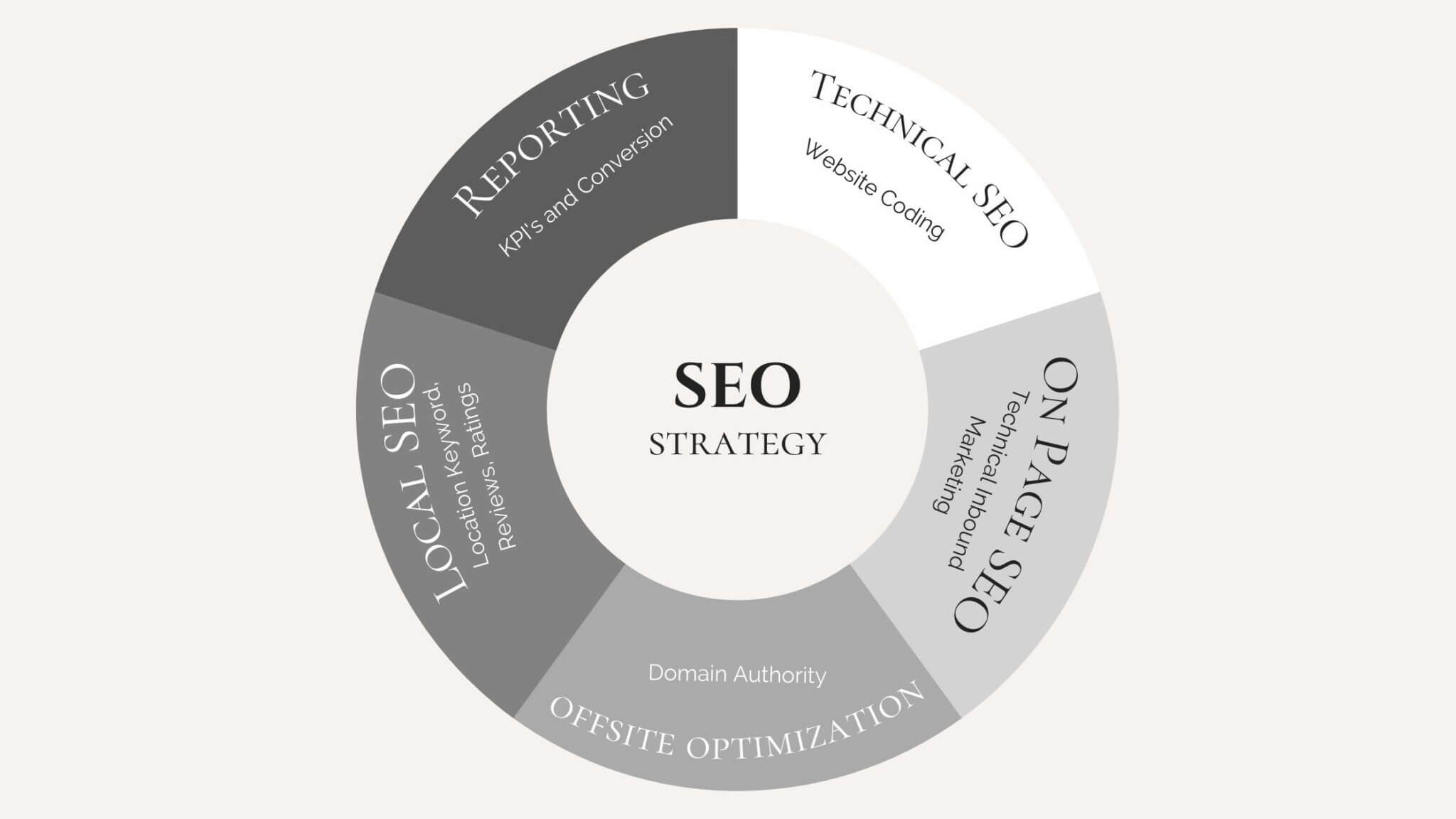How To Create an SEO Strategy – The 5 Parts of an SEO Strategy
Are you a business owner that is in the market for more clients? If you answered yes, then SEO strategy should be one of your top priorities, especially if chasing down and continually searching for new clients is starting to exhaust you!
Let’s be real, SEO is so confusing for many, and in case you didn’t know, the requirements for great SEO are continually changing. So in this article will break each part of Search Engine Optimization into biteable chunks so you know the framework as you build out your SEO strategy!
SEO: Search Engine Optimization
There are 5 KEY sections to a great SEO strategy. Each part actually takes speculation in and of itself. But for this article, it’s important to know the framework, especially if you are building out your own strategy or just want to talk confidently to a Search Engine Optimization expert.
Here we go….
The 5 parts of the SEO Strategy to improve your website’s search engine rankings are as follows: Technical, On-Page Optimization, Off-Site Optimization, Local, Reporting!
But before we go any further….
What exactly is an SEO strategy and why do you need one?
If you are looking to rank higher in search engines or frankly if you are ready for your target market to reach out to you, you must have a long-term game plan and a tried and true strategy to maximize your SEO. . You can’t just guess what people are searching for when researching a product or service! (Seriously, stop that!) Please use these tips and tricks to make sure that your company is the go-to resource for your target market.
An SEO strategy is a plan for boosting your site’s visibility in search engines, which ultimately leads to increased traffic and conversions.
A well-executed SEO campaign can help increase the organic rankings of your website by 5x or more!
Many small businesses have discovered the potential of utilizing on-page optimization and other SEO techniques.
Sasha Budko, CEO of Small Business Legal Help in Tampa Bay, FL when asked about the importance of marketing tactics like search engine optimization (SEO) to drive traffic on web pages said, “A lot of people might think that if they don’t have to spend money on SEO, that it’s just going to somehow happen.” But that’s not how SEO works. It takes time, money, patience, constancy, and most important a short and long-term strategy!
Why do I need an SEO strategy?
The best way to get ranked on Google’s SERPS (search engine results pages) is through inbound content marketing. On-page optimization (including keyword research, internal links, and outbound link strategies), technical analysis (load times/page speed improvements), local SEO considerations (geo-targeting capabilities like city+state combinations and NAP information), social media outreach with industry influencers – these are the 5 parts of an effective SEO strategy that will give you a boost in your website traffic and help drive leads to your services! But let’s break this down into bite-size junks!
1 – Technical SEO
Technical SEO includes examining and improving load time/page speed, finding and fixing broken links (internally and externally), fixing any crawl errors, improving the site’s mobile-friendliness, and examining/improving the website’s sitemap accessibility. This is one of the most overlooked but important parts of SEO management and it’s important to remember that your website is designed to maximize your technical SEO with clean code and simple solutions.
Other key items you might not be aware of that is part of your Technical SEO:
1 – Your SSL!
Did you know there are different types of SLL and some are more secure and more “google SEO friendly” than others? SLLs basically says, ‘your site is trustworthy’… but good SSL’s are re-encrypted at least once a month, give extra security to users by encrypting their passwords, cookies, customization on technical settings, and more. The more secure your SLL is the more google approves your website and the higher your chance of ranking.
2 – Mobile Design vs Mobile responsive.
Mobile responsive is the bare minimum your website should have but if you really want to improve your technical SEO – make sure your site is 100% mobile designed as well as standard design. Yup that means your website should be designed TWICE!
Plus there is a 55% increase in conversion rate when a site is mobile-designed vs mobile responsive.
3.1 Speed Up your Website – Clean Code
Let’s cut to the chase of what really bogs down your website, bad code, redundant, extra javascript, css, and fancy widgets, and huge media files over 100kb, all massively decreasing your technical SEO options. Sometimes you have to choose between form or function. Here at Easy As Pie design, we limit fancy options and suggest our clients choose function over form when given the choice. Our goal is to improve your bottom line and increase your SEO. Every extra second it takes for your potential client to buy from you is a second they will be jumping off your website and going somewhere else.
While creativity is important – making it stupid-simple for your target market to work with you is more important. Focus on what they need, give massive value, and solve their problems. That is why we focus on Story Brand design and implementation. It encourages creativity while also staying on task and helping your target market feel 100% confident hiring you.
3.2 Speed Up Your Website – Virtual Private Servers
“In layman’s terms, a server is a powerful computer that stores all of the data and files that make up your website. When someone types your domain name into their web browser, that powerful computer “serves up” your website to the searcher’s screen.
Now for the virtual aspect: VPS uses virtualization technology to split that one powerful server we just talked about into multiple virtual servers. Think of it this way: it’s one piece of physical hardware that functions like several separate servers.
The word private means just what it implies. Your virtual server is reserved for you, so you won’t have to share RAM, CPU, or any data with other users.” – https://www.dreamhost.com/blog/beginners-guide-vps/
This means you can increase your server load times between 5x-60x speeds than normal hosting servers. Usually, only large corporations or companies can afford their own personal servers. But with Easy As Pie Design, all of our hosting options automatically come with VPS!
But there is so much more! Here is a shortlist of more items you need to be aware of when taking Technical SEO into account:
- Javascript
- XML sitemaps
- Site architecture
- URL structure
- Structured data
- Thin content
- Duplicate content
- Hreflang
- Canonical tags
- 404 pages
- 301 redirects
Onpage SEO vs Offpage SEO:
“Site architecture on optimizing parts of your website that are within your control, while off-page SEO focuses on increasing the authority of your domain through content creation and earning backlinks from other websites. ” When you are asking How To Create an SEO Strategy, it’s important to really deep dive into these two areas.
2- On-Page SEO
On-page SEO includes extensive keyword research including a content audit to see if your on-page content satisfies search intent for specific keywords you want to rank higher in Google organic results pages. You can also create an internal link strategy that will help improve rankings for long-tail keywords by providing more relevant linking opportunities both internally and externally. This also includes items like:
- Outbound link strategies
- Keyword Research
- Content Audit
Internal Link Strategy outbound link audit and strategies, and ensuring the content is organized and providing users with a seamless experience. On-page SEO also includes outbound link audits to ensure that you don’t have any broken links on your website or external websites that link back to yours.
But there is more. On-Page SEO is all about inbound content marketing. It is the most powerful and cheap way to build your SEO ranking for your long-term goals. The great thing about on-page SEO is that it lasts for years, and continually compounds when done right and maintained and updated
1 Avoid thin content.
Thin content is when you give a little information to answer a question instead of an in-depth answer with examples, graphics, linkable solutions, and more. Thin content used to be a popular SEO strategy in 2014… but now, Google is smarter and you are going to be penalized if you use a thin–content SEO strategy.
2 Don’t duplicate content
Don’t create a solution then copy the whole page and just add in a different local geotag. This is just like a thin content tactic and it’s an old strategy that will massively backfire and do massive damage to your SEO goals.
- Search the keyword(s) you want your page to rank for
- Identify which pages are ranking highly for those keywords
- Determine what qualities those pages possess
- Create content that’s better than that!
This is where having a keyword strategy and planned SEO posts that increase your ranking is more important than just having a website. We would rather you have 12-24 high-ranking blog posts than 54 small ones.
More Checklist Items:
- Meta Tags
- Image Alt Tags/Text
- Header Tags
- Naming scheme
- Sitemap
- Indexing
- Broken Links
- Social Tags
3 – Off-site optimization
You can increase rankings through offsite optimization efforts like guest posting, influencer outreach campaigns, strategic blogger relations, and social media marketing. These are all methods used to get more of your target market on your website!
Some examples of maximizing Off-site SEO:
- Evaluate your backlink profile.
- Check your competitors’ backlink profiles.
- Improve your internal linking.
- Fix your 404 errors.
- Optimize your site’s on-page SEO.
- Assess your link-building options.
4 – Local SEO
Local SEO is the use of geotargeting considerations to improve your rankings in search results pages for searches that include a specific city+state combination. You can also get local optimization with NAP, or Name Address Phone information. This includes important data about what business you are so people will be more likely to click on your listing and visit your site when they’re researching purchases near them!
Some examples of maximizing local SEO:
- Know your ranking factors.
- Optimize your domain.
- Optimize Google My Business.
- Get social and get niche.
- Encourage user reviews and ratings.
- Generate backlinks and referral traffic.
- Don’t forget about mobile usability
5 – SEO Reporting
What does reporting encompass?
Reporting encompasses everything from Google Analytics (primarily) to competitive research/analysis, customer acquisition reports, conversion rates by channel – all of these help us make decisions like where we should spend our time and money on outbound link development next year for example. Reporting allows you as an executive-level decision-maker to make the best decisions possible when it comes to your marketing efforts.
Sample things to look for in your SEO reporting:
- Traffic channels
- Conversion rates
- Geographic Data
- Source Leads
- Page Traffic
- Time On-Site
- Bounce Rate
Search engine optimization is a complex process of human behavior and cognition. More than likely, if you are struggling to win customers either haven’t been prospecting and using inbound marketing to its fullest advantage while executing a solid SEO strategy.
In this article, you learned about SEO strategy for beginners by reading through five SEO parts: technical, on-page, off-site, local, reporting. If you are struggling with any marketing part including SEO strategy please free to contact us, so we can help! We have experts ready to partner with you when it comes to your digital marketing plan needs – whether that means creating quality content or improving your website’s rankings online based on what matters most to your target market.







0 Comments